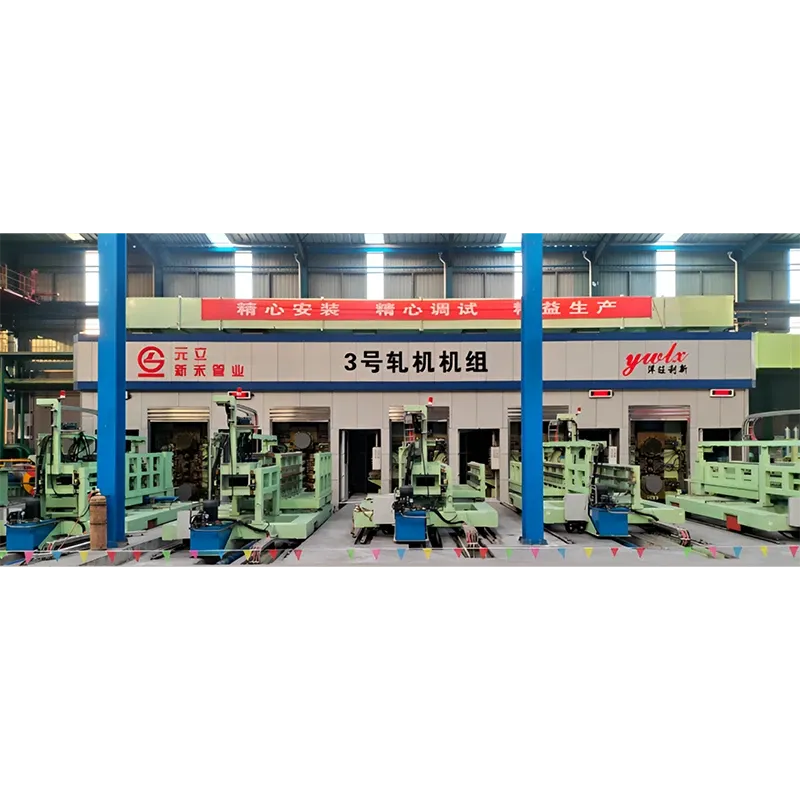
Automation and Process Control in Tandem Cold Rolling Mills
Modern tandem cold rolling mills represent the pinnacle of automated metal processing, where sophisticated control systems orchestrate every aspect of production with remarkable precision. These highly automated tandem mill cold rolling operations have transformed from manually-intensive processes to technological marvels where computer systems make split-second decisions that human operators could never match. The transition to full automation in tandem cold rolling mills has enabled manufacturers to achieve unprecedented levels of product consistency, operational efficiency, and quality control while processing materials at speeds exceeding 2,500 meters per minute.

The automation architecture in today's tandem cold metal rolling mill control systems typically follows a hierarchical structure with multiple layers of control. At the base level, programmable logic controllers (PLCs) manage individual equipment functions, while intermediate systems coordinate stand-level operations. The supervisory control and data acquisition (SCADA) system provides plant-wide oversight, integrating data from hundreds of sensors to optimize the entire production line. This multi-tiered approach allows tandem mill rolling operations to maintain micron-level thickness tolerances while adapting to changing material properties and process conditions in real time.
Core Control Systems in Tandem Cold Rolling Mills
The technological backbone of any tandem cold rolling mill consists of several specialized control systems working in perfect synchronization. The automatic gauge control (AGC) system maintains precise thickness by continuously adjusting roll gaps based on real-time thickness measurements. This critical subsystem works in conjunction with tension control loops that manage interstand stresses, and speed control systems that synchronize multiple stands to ensure smooth material flow. Together, these systems form an integrated tandem cold metal rolling mill control network that responds to process variations within milliseconds.
Modern tandem mill cold rolling operations employ advanced control algorithms that go beyond traditional PID (proportional-integral-derivative) approaches. Adaptive control systems automatically tune their parameters based on changing process conditions, while model predictive control (MPC) uses mathematical models to anticipate and prevent quality deviations. Some cutting-edge installations now incorporate artificial intelligence elements that learn from historical data to optimize rolling parameters for specific product grades. These intelligent control strategies enable tandem cold rolling mills to maintain tighter tolerances while reducing material waste and energy consumption.
Tandem Cold Rolling Mills: Human-Machine Interface and Operator Control Stations
While tandem cold rolling mills operate with a high degree of autonomy, human oversight remains essential for optimal performance. Modern control rooms feature ergonomic operator stations with high-resolution displays presenting real-time process visualizations. These human-machine interfaces (HMIs) transform raw sensor data into intuitive graphical representations, allowing mill personnel to monitor multiple stands simultaneously. Advanced diagnostic screens help operators quickly identify and address any process deviations that may occur during tandem mill cold rolling operations.
The latest generation of tandem cold metal rolling mill control systems incorporates augmented reality features that overlay critical process information onto video feeds of the mill. Operators can access detailed historical trends, predictive analytics, and maintenance information through touchscreen interfaces, enabling faster, more informed decision-making. Alarm management systems prioritize notifications based on severity, preventing information overload while ensuring important events receive immediate attention. These sophisticated interfaces bridge the gap between complex automation systems and human operators, creating a collaborative environment where both work together to maximize mill performance.
Tandem Cold Rolling Mills: Integration with Plant-Wide Automation Systems
Modern tandem cold rolling mills don't operate in isolation but rather as integrated components of comprehensive manufacturing execution systems (MES). These plant-wide networks connect tandem mill rolling operations with upstream and downstream processes, creating a seamless production flow from raw material to finished product. The tandem cold metal rolling mill control system exchanges data with inventory management, quality assurance, and maintenance scheduling systems, enabling coordinated optimization across all operational areas.
This integration extends beyond the physical plant through industrial Internet of Things (IIoT) technologies that connect mills with corporate ERP systems and supply chain networks. Real-time production data from tandem cold rolling mills feeds into enterprise-level analytics platforms that identify opportunities for continuous improvement. Some manufacturers have implemented cloud-based monitoring systems that allow remote experts to assist with troubleshooting and optimization, reducing downtime and improving overall equipment effectiveness (OEE). This level of connectivity represents the future of tandem mill cold rolling operations, where data flows freely across organizational boundaries to drive operational excellence.
Tandem Cold Rolling Mills: Advanced Process Optimization Techniques
The automation systems in modern tandem cold rolling mills employ sophisticated optimization algorithms that continuously seek the most efficient operating parameters. These systems analyze multiple variables simultaneously—including rolling speed, reduction ratios, tension levels, and lubrication conditions—to find the ideal balance between productivity, quality, and energy consumption. The tandem cold metal rolling mill control system can automatically adjust these parameters in response to changes in material properties or product specifications, maintaining optimal performance throughout production runs.
Some of the most advanced tandem mill rolling operations now utilize artificial intelligence for predictive optimization. Machine learning algorithms analyze historical production data to identify patterns and correlations that human engineers might overlook. These intelligent systems can recommend rolling schedules that minimize energy use while meeting quality targets, or predict the optimal time for work roll changes to maximize productivity. As these AI models continue to learn from ongoing operations, their ability to optimize tandem cold rolling mill performance improves correspondingly, creating a virtuous cycle of continuous improvement.
-
YWLX’s 1450mm Six-Hi Reversing Mill Goes Live in BangladeshNewsNov.24,2025
-
Adjusting Roll Gap in 6Hi Reversing Cold Rolling Mill for Thin StripNewsNov.13,2025
-
Quality Control Standards for Automatic Gauge Control in Strip RollingNewsNov.13,2025
-
Effect of Skin Pass Rolling on Metal DuctilityNewsNov.13,2025
-
Key Components of a Modern TempermillNewsNov.13,2025
-
Common Wear Patterns of Work Roll in Tandem Cold Mill OperationsNewsNov.13,2025
-
Revolutionary Skin Pass Rolling Technology for Enhanced Steel QualityNewsNov.04,2025










